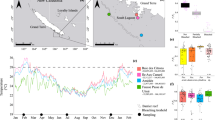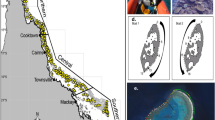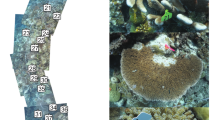Abstract
The cryptofauna are the small cryptic organisms that inhabit the interstices of coral colonies and have a great contribution to the biodiversity of the reef. Some of these species are vulnerable to environmental deterioration due to their dependency on living coral. In the 1990s, Culebra Bay, located in the North Pacific of Costa Rica, was considered one of the most important reef areas in the country, with a mean live coral cover over 40%. However, in the last two decades there was a drastic decrease in live coral cover to 5%, due to El Niño events and recurrent harmful phytoplankton blooms. To evaluate the effect of the deterioration of the reef on the cryptofauna, we compare two time periods: before (2003–2004) and after (2013–2014) coral decline. Pocillopora spp. colonies (~20 cm high by ~20 cm wide) were collected and all associated invertebrates removed. Twenty colonies were sampled each period. During the first period, sampled colonies were alive and healthy, whereas a decade later, exposed skeletons of dead colonies were sampled. A total of 3482 invertebrate individuals were found, belonging to 133 species, 72 families, and nine classes. While abundance and diversity were greater during the 2013–2014 period, we hypothesize that this is due to disturbance intensity being intermediate to high. If these conditions are persistent or intensify over time, however, we expect that once all substrate and reef structure is lost, an abrupt decline in cryptofauna abundance and diversity will take place. Reefs with dead corals therefore have a remarkably different composition of the cryptofauna. Obligate commensal fauna were replaced by boring, opportunistic, and facultative species in these habitats. These changes in live coral cover favored an increase in the diversity of organisms, but this enhanced diversity may be temporary as bioerosion reduces dead colonies to skeleton rubble. This change in the cryptofauna community can affect the recovery and sustainability of the reef ecosystem over time.




Similar content being viewed by others
References
Alfaro EJ, Cortés J, Alvarado JJ, Jiménez C, León A, Sánchez-Noguera C, Nivia-Ruiz J, Ruiz-Campos E (2012) Clima y variabilidad climática de la temperatura subsuperfical del mar en Bahía Culebra, Guanacaste, Costa Rica. Rev Biol Trop 60(Supl. 2):159–171
Alvarado JJ, Vargas-Castillo R (2012) Invertebrados asociados al coral constructor de arrecifes, Pocillopora damicornis en Playa Blanca, Bahía Culebra, Costa Rica. Rev Biol Trop 60(Supl. 2):77–92
Alvarado JJ, Cortés J, Reyes-Bonilla H (2012) Reconstruction of Diadema mexicanum a. Agassiz, 1863 bioerosion impact on three Costa Rican Pacific coral reefs. Rev Biol Trop 60(Suppl. 2):121–132
Alvarado JJ, Beita-Jiménez A, Mena S, Fernández-García C, Cortés J, Sánchez-Noguera C, Jiménez C, Guzmán AG (2018) Cuando la conservación no puede seguir el ritmo del desarrollo: Estado de salud de los ecosistemas coralinos del Pacífico Norte de Costa Rica. Rev Biol Tro 66(Supl. 1):280–308. https://doi.org/10.15517/RBT.V66I1.33300
Anderson MJ (2001) A new method for non-parametric multivariate analysis of variance. Austral Ecol 26:32–46. https://doi.org/10.1046/j.1442-9993.2001.01070.x
Apprill A (2020) The role of symbioses in the adaptation and stress responses of marine organisms. Annu Rev Mar Sci 12:291–314. https://doi.org/10.1146/annurev-marine-010419-010641
Arias-Godínez G, Jiménez C, Gamboa C, Cortés J, Espinoza M, Alvarado JJ (2019) Spatial and temporal changes of reef fish assemblages on disturbed coral reefs, North Pacific coast of Costa Rica. Mar Ecol 40:e12532. https://doi.org/10.1111/maec.12532
Bascompte J, Stouffer DB (2009) The assembly and disassembly of ecological networks. Phil Trans Royal Soc London Biol Sci 364:1781–1788. https://doi.org/10.1098/rstb.2008.0226
Bellwood DR, Hughes TP, Folke C, Nyström M (2004) Confronting the coral reef crisis. Nature 429:827–933. https://doi.org/10.1038/nature02691
Boström-Einarsson L, Babcock RC, Bayraktarov E, Ceccarelli D, Cook N, Ferse SCA, Boze H, Harrison P, Hein M, Shaver E, Smith A, Suggett D, Stewart-Sinclair PJ, Vardi T, McLeod IM (2020) Coral restoration – a systematic review of current methods, successes, failures and future directions. PLoS One 15:e0226631. https://doi.org/10.1371/journal.pone.0226631
Castro P (1976) Brachyuran crabs symbiotic with scleractinian corals: a review of their biology. Micronesica 12:99–110
Castro P (1988) Animal symbioses in coral reef communities: a review. Symbiosis 5:161–184
Castro P (1996) Eastern Pacific species of Trapezia (Crustacea, Brachyura: Trapeziidae) sibling species symbiotic with reef corals. Bull Mar Sci 58:531–554
Clark HL (1940) Eastern Pacific expeditions of the New York zoological society. XXI Notes on Echinoderms from the west coast of Central America Zoologica 25:331–352
Clarke KR, Gorley RN (2006) PRIMER v6: User manual. PRIMER-E Ltd, Plymouth
Coan EV, Valentich-Scott P (2012) Bivalve seashells of tropical West America. Marine bivalve mollusks from Baja California to Peru. Santa Barbara Museum Natural History, Santa Barbara
Coleman MA, Wood G, Filbee-Dexter K, Minne AJP, Goold HD, Vergés A, Marzinelli EM, Steinberg PD, Wernberg T (2020) Restore or redefine: future trajectories for restoration. Front Mar Sci 7:237. https://doi.org/10.3389/fmars.2020.00237
Coles S (1980) Species diversity of decapods associated with living and dead reef coral Pocillopora meandrina. Mar Ecol Prog Ser 2:281–291
Cortés J, Jiménez CE (2003) Corals and coral reefs of the Pacific of Costa Rica: history, research and status. In: Cortés J (ed) Latin American coral reefs. Elsevier, Amsterdam, pp 361–385
Cortés J, Vargas-Castillo R, Nivia-Ruiz J (2012) Marine biodiversity of Bahía Culebra, Guanacaste, Costa Rica: published records. Rev Biol Trop 60(Suppl 2):39–71
Cortés J, Enochs IC, Sibaja-Cordero J, Hernández L, Alvarado JJ, Breedy O, Cruz-Barraza JA, Esquivel-Garrote O, Fernández-García C, Hermosillo A, Kaiser KL, Medina-Rosas P, Morales-Ramírez Á, Pacheco C, Reyes-Bonilla H, Riosmena-Rodríguez R, Sánchez-Noguera C, Zapata FA (2017) Marine biodiversity of eastern tropical Pacific coral reefs. In: Glynn PW, Manzello DP, Enochs IC (eds) Coral reefs of the eastern tropical Pacific: persistence and loss in a dynamic environment. Springer, Berlin, pp 203–250
Counsell CWW, Donahue MJ, Edwards KF, Franklin EC, Hixon MA (2018) Variation in coral-associated cryptofaunal communities across spatial scales and environmental gradients. Coral Reefs 37:827–840. https://doi.org/10.1007/s00338-018-1709-7
Dominici-Arosemena A, Brugnoli-Olivera E, Cortés-Núñez J, Molina-Ureña H, Quesada-Alpízar M (2005) Community structure of eastern Pacific reef fishes (gulf of Papagayo, Costa Rica). Tecnociencia 7:19–41
Doo SS, Carpenter RC, Edmunds PJ (2018) Obligate ectosymbionts increase the physiological resilience of a scleractinian coral to high temperature and elevated pCO2. Coral Reefs 37:997–1001. https://doi.org/10.1007/s00338-018-1731-9
Enochs IC (2012) Motile cryptofauna associated with live and dead coral substrates: implications for coral mortality and framework erosion. Mar Biol 159:709–722. https://doi.org/10.1007/s00227-011-1848-7
Enochs IC, Hockensmith G (2009) Effects of coral mortality on the community composition of cryptic metazoans associated with Pocillopora damicornis. Proc 11th Int Coral Reef Symp 26:1368–1372
Enochs IC, Manzello DP (2012a) Species richness of motile cryptofauna across a gradient of reef framework erosion. Coral Reefs 31:653–661. https://doi.org/10.1007/s00338-012-0886-z
Enochs IC, Manzello DP (2012b) Responses of cryptofaunal species richness and trophic potential to coral reef habitat degradation. Diversity 2012:94–104. https://doi.org/10.3390/d4010094
Enochs IC, Toth LT, Brandtneris VW, Afflerbach JC, Manzello DP (2011) Environmental determinants of motile cryptofauna on an eastern Pacific coral reef. Mar Ecol Prog Ser 438:105–118. https://doi.org/10.3354/meps09259
Fauchald K (1977) The polychaete worms. Definitions and keys to the orders, families and genera. Nat Hist Mus LA County Sci Ser 28:1–188
Fernández-García C, Cortés J, Alvarado JJ, Nivia-Ruiz J (2012) Physical factors contributing to the benthic dominance of the alga Caulerpa sertularioides (Caulerpaceae, Chlorophyta) in the upwelling Bahía Culebra, North Pacific of Costa Rica. Rev Biol Trop 60(Suppl. 2):93–107
Fonseca AC, Dean HK, Cortés J (2006) Non-colonial coral macroborers as indicators of coral reef stress in the South Pacific of Costa Rica. Rev Biol Trop 54:101–115
Goral F, Schellenberg J (2018) Goeveg: functions for community data and ordinations. R package version 0.4.2. https://CRAN.R-project.org/package=goeveg
Haig J (1960) The Porcellanidae (Crustacea: Anomura) of the eastern Pacific. Allan Hancock Pac Exped 24:1–440
Head CEI, Bonsall MB, Koldewey H, Pratchett MS, Speight M, Rogers AD (2015) High prevalence of obligate coral-dwelling decapods on dead corals in the Chagos archipelago, Central Indian Ocean. Coral Reefs 34:05–915. https://doi.org/10.1007/s00338-015-1307-x
Hernández L, Reyes-Bonilla H, Balart EF (2010) Efecto del blanqueamiento del coral por baja temperatura en los crustáceos decápodos asociados a arrecifes del suroeste del golfo de California. Rev Mex Biodiv 81:S113–S119. https://doi.org/10.22201/ib.20078706e.2010.0.214
Hiatt RW, Strasburg DW (1960) Ecological relationships of the fish fauna on coral reefs of the Marshall Islands. Ecol Monogr 30:65–127
Holthuis LB (1951) A general revision of the Palaemonidae (Crustacea: Decapoda: Natantia) of the Americas. I. the subfamilies Euryrhynchinae and Pontoniinae. Occ Pap Allan Hancock Found 11:1–332
Holthuis LB (1952) A general revision of the Palaemonidae (Crustacea: Decapoda: Natantia) of the Americas, part. II. The subfamily Palaemoninae. Occ Pap Allan Hancock Found 12:1–396
Jiménez C (2001) Arrecifes y ambientes coralinos de Bahía Culebra, Pacífico de Costa Rica: aspectos biológicos, económico-recreativos y de manejo. Rev Biol Trop 49(Supl 2):215–231
Jiménez C (2007) Arrecifes coralinos, ¿víctimas de los cambios? Ambientico 171:5–7
Keen AM (1971) Sea shells of tropical West America: marine mollusks from Baja California to Peru. Stanford University, Stanford
Kim W, Abele LG (1988) The snapping shrimp genus Alpheus from the eastern Pacific (Decapoda: Caridea: Alpheidae). Smithson Contr Zool 454:1–119
Knudsen JW (1967) Trapezia and Tetralia (Decapoda, Brachyura, Xanthidae) as obligate ectoparasites of pocilloporid and acroporid corals. Pac Sci 21:51–57
Kramer MJ, Bellwood DR, Bellwood O (2014) Benthic Crustacea on coral reefs: a quantitative survey. Mar Ecol Prog Ser 511:105–116. https://doi.org/10.3354/meps10953
Lecchini D, Nakamura Y (2013) Use of chemical cues by coral reef animal larvae for habitat selection. Aquat Biol 19(3):231–238. https://doi.org/10.3354/ab00532
Lecchini D, Miura T, Lecellier G, Banaigs B, Nakamura Y (2014) Transmission distance of chemical cues from coral habitats: implications for marine larval settlement in context of reef degradation. Mar Biol 161(7):1677–1686. https://doi.org/10.1007/s00227-014-2451-5
Lieske E, Myers R (1994) Coral reef fishes—indo-Pacific and Caribbean. Harper Collins, London
McKeon CS, Moore JM (2014) Species and size diversity in protective services offered by coral guard-crabs. PeerJ 2:e574. https://doi.org/10.7717/peerj.574
Montoya JM, Solé RV (2002) Small world patterns in food webs. J Theor Biol 214:405–412. https://doi.org/10.1006/jtbi.2001.2460
Montoya JM, Pimm SL, Solé RV (2006) Ecological networks and their fragility. Nature 442:259–264. https://doi.org/10.1038/nature04927
Nelson HR, Kuempel CD, Altieri AH (2016) The resilience of reef invertebrate biodiversity to coral mortality. Ecosphere 7:e01399. https://doi.org/10.1002/ecs2.1399
Noorbaini Samsuri A, Preslie Kikuzawa Y, Taira D, Qin Sam S, Ting Sim W, Lionel Ng CS, Afiq-Rosli L, Delon Wee TW, Kee Ng N, Chong Toh T, Ming Chou L (2018) The effectiveness of Trapezia cymodoce in defending its host coral Pocillopora acuta against corallivorous Drupella. Mar Biol 65:70. https://doi.org/10.1007/s00227-018-3330-2
Oksanen J, Blanchet FG, Friendly M, Kindt R, Legendre P, McGlinn D, Minchin PR, O'Hara RB, Simpson GL, Solymos P, Stevens MHM, Szoecs E, Wagner H (2019) Vegan: community ecology package. R package version 2:5–6 https://CRAN.R-project.org/package=vegan
Owada M (2007) (2007) functional morphology and phylogeny of the rock-boring bivalves Leiosolenus and Lithophaga (Bivalvia: Mytilidae): a third functional clade. Mar Biol 150:853–860. https://doi.org/10.1007/s00227-006-0409-y
Owada M (2015) Functional phenotypic plasticity of the endolithic mytilid Leiosolenus curtus (Lischke, 1874) (Bivalvia: Mytilidae). Molluscan Res 35:188–195. https://doi.org/10.1080/13235818.2015.1052129
Plaisance L, Knowlton AN, Paulay AG, Meyer AC (2009) Reef associated crustacean fauna: biodiversity estimates using semiquantitative sampling and DNA barcoding. Coral Reefs 28:977–986. https://doi.org/10.1007/s00338-009-0543-3
Pratchett MS (2001) Influence of coral symbionts on feeding preferences of crown-of-thorns starfish Acanthaster planci in the western Pacific. Mar Ecol Prog Ser 214:111–119. https://doi.org/10.3354/meps214111
Pratchett MS, Vytopil E, Parkes P (2000) Coral crabs influence the feeding patterns of crown-of-thorns starfish. Coral Reefs 19:36. https://doi.org/10.1007/s003380050223
Printrakoon C, Yeemin T, Valentich-Scott P (2016) Ecology of endolithic bivalve mollusks from Ko Chang, Thailand. Zool Stud 55:50. https://doi.org/10.6620/ZS.2016.55-50
R Development Core Team (2019) R: a language and environment for statistical computing. Retrieved from http://www.r-project.org/
Reaka-Kudla M (1997) The global biodiversity of coral reefs: a comparison with rain forests. In: Reaka-Kudla M, Wilson DE, Wilson EO (eds) Biodiversity II: understanding and protecting our biological resources. Joseph Henry Press, Washington, D.C, pp 83–108
Rixen T, Jiménez C, Cortés J (2012) Impact of upwelling events on the sea water chemistry in the Gulf of Papagayo (Culebra Bay), Costa Rica. Rev Biol Trop 60(Suppl 2):187–195
Rotjan RD, Lewis SM (2008) Impact of coral predators on tropical reefs. Mar Ecol Prog Ser 367:73–91. https://doi.org/10.3354/meps07531
Rouzé H, Lecellier G, Mills SC, Planes S, Berteaux-Lecellier V, Stewart H (2014) Juvenile Trapezia spp. crabs can increase juvenile host coral survival by protection from predation. Mar Ecol Prog Ser 515:151–159. https://doi.org/10.3354/meps10970
Salgado-Barragán P, Hendrickx M (2010) Clave ilustrada para la identificación de los estomatópodos (Crustacea:Hoplocarida) del Pacífico oriental. Rev Mex Biod 81:1–49. https://doi.org/10.22201/ib.20078706e.2010.0.224
Sánchez-Noguera C, Jiménez C, Cortés J (2018a) Desarrollo costero y ambientes marino-costeros en Bahía Culebra, Guanacaste, Costa Rica. Rev Biol Trop 66(Supl 1):S309–S327. https://doi.org/10.15517/rbt.v66i1.33301
Sánchez-Noguera C, Stuhldreier I, Cortés J, Jiménez C, Morales Á, Wild C, Rixen T (2018b) Natural Ocean acidification at Papagayo upwelling system (North Pacific Costa Rica): implications for reef development. Biogeosci 15:2349–2360. https://doi.org/10.5194/bg-15-2349-2018
Skoglund C (1992) Additions to the Panamic province gastropod (Mollusca) literature 1971 to 1992. Festivus 24:1–169
Skoglund C (2002) Panamic province molluscan literature: additions and changes from 1971 through 2001. III Gastropoda Festivus 32:201–286
Steinberg PD, De Nys R, Kjelleberg S (2002) Chemical cues for surface colonization. J Chem Ecol 28(10):1935–1951. https://doi.org/10.1023/A:1020789625989
Stella JS, Munday PL, Jones GP (2011a) Effects of coral bleaching on the obligate coral-dwelling crab Trapezia cymodoce. Coral Reefs 30:719–727. https://doi.org/10.1007/s00338-011-0748-0
Stella JS, Pratchett MS, Hutchings PA, Jones GP (2011b) Coral-associated invertebrates: diversity, ecological importance and vulnerability to disturbance. Oceanogr Mar Biol Ann Rev 49:43–104
Stewart HL, Holbrook SJ, Schmitt RJ, Brooks AJ (2006) Symbiotic crabs maintain coral health by clearing sediments. Coral Reefs 25:609–615. https://doi.org/10.1007/s00338-006-0132-7
Stewart HL, Price NN, Holbrook SJ, Schmitt RJ, Brooks AJ (2013) Determinants of the onset and strength of mutualistic interactions between branching corals and associate crabs. Mar Ecol Prog Ser 493:155–163. https://doi.org/10.3354/meps10525
Stier AC, McKeon CS, Osenberg CW, Shima JS (2010) Guard crabs alleviate deleterious effects of vermetid snails on a branching coral. Coral Reefs 29:1019–1022. https://doi.org/10.1007/s00338-010-0663-9
Tóth E, Duffy JE (2005) Coordinated group response to nest intruders in social shrimp. Biol Lett 1(1):49–52. https://doi.org/10.1098/rsbl.2004.0237
Wee SYC, Sam SO, Sim WT, Ng CSL, Taira D, Afiq-Rosli L, Kikuzawa YP, Toh TC, Chou LM (2019) The role of in situ coral nurseries in supporting mobile invertebrate epifauna. J Nat Conserv 50:125710. https://doi.org/10.1016/j.jnc.2019.125710
Williams RJ, Berlow EL, Dunne JA, Barabási AL, Martínez ND (2002) Two degrees of separation in complex food webs. Proc Natl Acad Sci U S A 99:12913–12916. https://doi.org/10.1073/pnas.192448799
Wizemann A, Nandini SD, Stuhldreier I, Sánchez-Noguera C, Wisshak M, Westphal H, Rixen T, Wild C, Reymond CE (2018) Rapid bioerosion in a tropical upwelling coral reef. PLoS One 13:e0202887. https://doi.org/10.1371/journal.pone.0202887
Acknowledgements
The present investigation would not have been possible without the support of the following people and institutions: C. Fernández-García, J. Nivia-Ruiz, K. García, J.C. Azofeifa, S. Mena, A. Beita, Deep Blue Diving, Ecodesarrollo Papagayo S.A., Instituto Costarricense de Turismo (ICT), and Centro de Investigación en Ciencias del Mar y Limnología (CIMAR). We are grateful to B. Chomitz, for his review and comments that improved this paper.
Funding
This project was financed through the fund 1312–01 of the Foundation of the University of Costa Rica.
Author information
Authors and Affiliations
Contributions
Conceptualization: JJA, CSM.
Methodology and field work: JJA, CSM.
Data analysis: All authors.
Original draft: JJA, CSM, SFM.
Review and edition of the final draft: all authors.
All authors read and approved the final manuscript.
Corresponding author
Ethics declarations
Conflict of interest
The authors declare they have no conflict of interest.
Additional information
Publisher’s note
Springer Nature remains neutral with regard to jurisdictional claims in published maps and institutional affiliations.
Rights and permissions
About this article
Cite this article
Salas-Moya, C., Fabregat-Malé, S., Vargas-Castillo, R. et al. Pocillopora cryptofauna and their response to host coral mortality. Symbiosis 84, 91–103 (2021). https://doi.org/10.1007/s13199-021-00771-7
Received:
Accepted:
Published:
Issue Date:
DOI: https://doi.org/10.1007/s13199-021-00771-7




